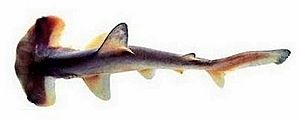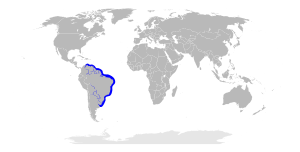Smalleye hammerhead shark facts for kids
Quick facts for kids Smalleye hammerhead shark |
|
|---|---|
 |
|
| Conservation status | |
| Scientific classification | |
| Kingdom: | |
| Phylum: | |
| Class: | |
| Subclass: | |
| Order: | |
| Family: | |
| Genus: | |
| Species: |
S.tudes
|
 |
|
| Map of where the smalleye hammerhead shark is found (In blue) | |
The smalleye hammerhead shark (Sphyrna tudes), also known as the "golden hammerhead" or the "curry shark", is a small species in the hammerhead shark group, and is found in the shallow coastal waters of the western Atlantic Ocean from Venezuela to Uruguay. It likes to live in muddy habitats. Like all other hammerhead sharks, the smalleye hammerhead shark has a "hammer" (also known as the "cephalofoil") on its head.
Description
The smalleye hammerhead shark is a small member of the hammerhead shark group, reaching up to the length of 1.5 meters (4.9 ft) long, but ones which are 1.2-1.3 meters (3.9-4.3 ft) long are more common. They weigh around 9 kg. The cephalofoil is wide and long, measuring up to 28-32% of the body length. The eyes, which are placed at the ends of the cephalofoil, are smaller than the eyes of other hammerhead sharks and have a third eyelid. The nostrils are placed inside the eyes.
Young smalleye hammerhead sharks are grey on the top and are white below. When they reach the length of 45 cm (18 in) their undersides start turning yellow, which turns to orange when they are 50 cm (20 in) long. The golden colour then comes when they are 55–70 cm (22–28 in) long, but fades when they become mature.
Where they live
The smalleye hammerhead shark is found along the eastern coast of South America, from Uruguay to Venezuela, but it is sometimes found further west than the Orinoco Delta southeast of Trinidad. They have been unconfirmed reports of this shark being found off Panama, Mexico, and western Florida. It is the most common shark of where it lives. The smalleye hammerhead shark also is found in inshore murky waters which are 5-40 meters (16-130 ft) deep. Newborns and young ones which are under 40 cm (16 in) long, are found in the shallowest waters, and move deeper as they grow older. Adult females are mostly found in water which is 9-18 meters (30-59 ft) deep, while adult males are mostly found at the depths of 27-36 meters (89–118 ft).
Behaviour
There are four other species of hammerhead sharks which live in the same area as the smalleye hammerhead shark lives: the scoophead, the bonnethead, the great hammerhead shark and the scalloped hammerhead shark. There is little competition between these sharks because of their different habitats and eating. Adult males and young ones of both genders come together and form groups, although these groups to not seem to be made for reproduction or migration. Adult females seem to live alone.
Young smalleye hammerhead sharks which are under the length of 67 cm (26 inches) feed mostly on penaeid shrimp, while larger ones feed mainly on bony fish, especially ariid sea catfish and their eggs. The shrimp and the surface mucus layer and eggs of the catfish contain carotenoid pigments which seem to cause the golden colour of the shark. Another shark which lives in the same area as the smalleye hammerhead shark, the Yellow smooth-hound (Mustelus higmani), also feeds on shrimp and has a yellowish colour on it, but it is not as bright as the colour on the smalleye hammerhead shark. The smalleye hammerhead shark is also known to eat swimming crabs, squid, and newborn scalloped hammerhead sharks.
The smalleye hammerhead shark has been known to be eaten by larger sharks such as the bull shark (Carcharhinus leucas), and sometimes it has been eaten by bony fishes.
Reproduction
Like most other hammerhead sharks, the smalleye hammerhead shark is viviparous, meaning that it gives live birth. They mate in August and September and females are pregnant for around 10 months before giving birth to 5-12 pups in May and June. Males and females mature when they are 80 to 98 cm (31 to 39 inches) long. But male smalleye hammerhead sharks found off the northern Brazilian state of Maranhão mature when they are 92 cm (36 cm) long, while females mature when they are over 101 cm (40 in) long.
Human interactions
Shy and harmless towards humans, smalleye hammerhead sharks are fished throughout its range and is sold as food. Overfishing has now caused populations of the smalleye hammerhead shark to decrease. This has led the International Union for the Conservation of Nature to list it under Vulnerable.


